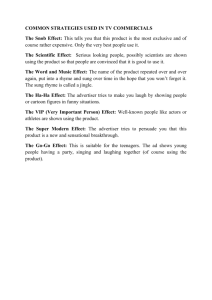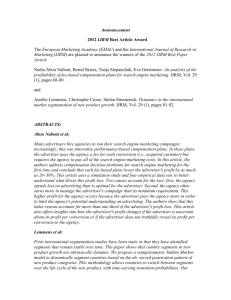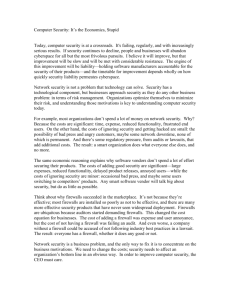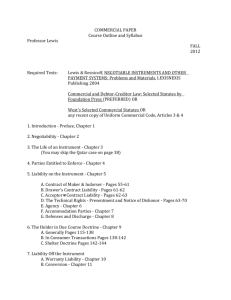Avoiding Liability Battles
advertisement
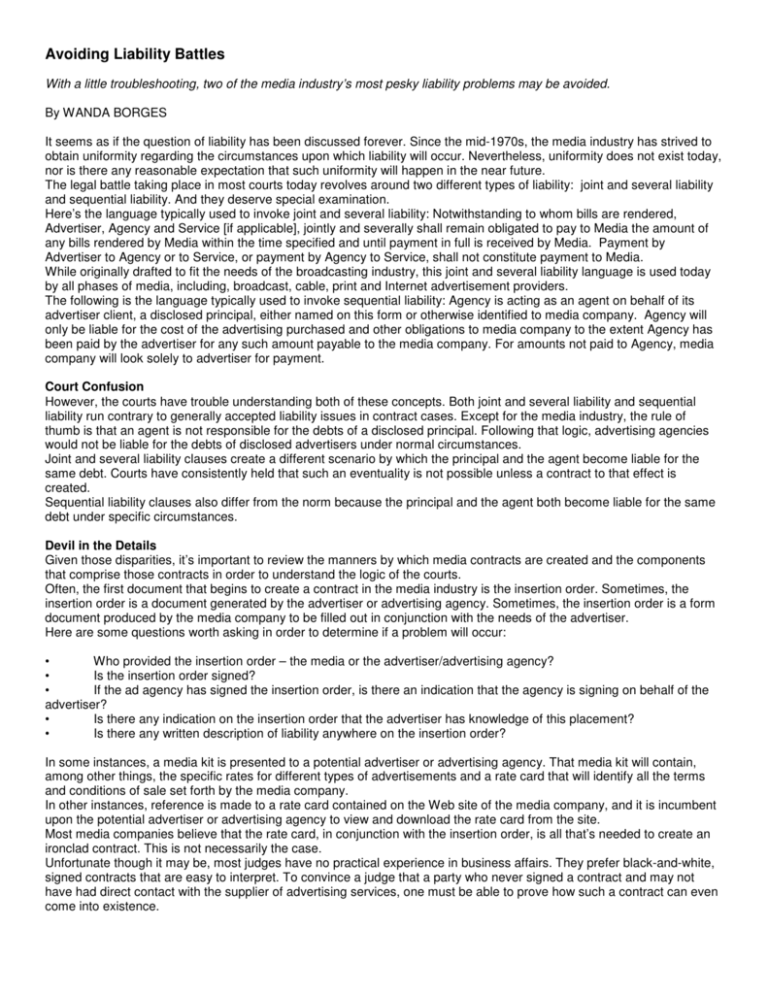
Avoiding Liability Battles With a little troubleshooting, two of the media industry’s most pesky liability problems may be avoided. By WANDA BORGES It seems as if the question of liability has been discussed forever. Since the mid-1970s, the media industry has strived to obtain uniformity regarding the circumstances upon which liability will occur. Nevertheless, uniformity does not exist today, nor is there any reasonable expectation that such uniformity will happen in the near future. The legal battle taking place in most courts today revolves around two different types of liability: joint and several liability and sequential liability. And they deserve special examination. Here’s the language typically used to invoke joint and several liability: Notwithstanding to whom bills are rendered, Advertiser, Agency and Service [if applicable], jointly and severally shall remain obligated to pay to Media the amount of any bills rendered by Media within the time specified and until payment in full is received by Media. Payment by Advertiser to Agency or to Service, or payment by Agency to Service, shall not constitute payment to Media. While originally drafted to fit the needs of the broadcasting industry, this joint and several liability language is used today by all phases of media, including, broadcast, cable, print and Internet advertisement providers. The following is the language typically used to invoke sequential liability: Agency is acting as an agent on behalf of its advertiser client, a disclosed principal, either named on this form or otherwise identified to media company. Agency will only be liable for the cost of the advertising purchased and other obligations to media company to the extent Agency has been paid by the advertiser for any such amount payable to the media company. For amounts not paid to Agency, media company will look solely to advertiser for payment. Court Confusion However, the courts have trouble understanding both of these concepts. Both joint and several liability and sequential liability run contrary to generally accepted liability issues in contract cases. Except for the media industry, the rule of thumb is that an agent is not responsible for the debts of a disclosed principal. Following that logic, advertising agencies would not be liable for the debts of disclosed advertisers under normal circumstances. Joint and several liability clauses create a different scenario by which the principal and the agent become liable for the same debt. Courts have consistently held that such an eventuality is not possible unless a contract to that effect is created. Sequential liability clauses also differ from the norm because the principal and the agent both become liable for the same debt under specific circumstances. Devil in the Details Given those disparities, it’s important to review the manners by which media contracts are created and the components that comprise those contracts in order to understand the logic of the courts. Often, the first document that begins to create a contract in the media industry is the insertion order. Sometimes, the insertion order is a document generated by the advertiser or advertising agency. Sometimes, the insertion order is a form document produced by the media company to be filled out in conjunction with the needs of the advertiser. Here are some questions worth asking in order to determine if a problem will occur: • Who provided the insertion order – the media or the advertiser/advertising agency? • Is the insertion order signed? • If the ad agency has signed the insertion order, is there an indication that the agency is signing on behalf of the advertiser? • Is there any indication on the insertion order that the advertiser has knowledge of this placement? • Is there any written description of liability anywhere on the insertion order? In some instances, a media kit is presented to a potential advertiser or advertising agency. That media kit will contain, among other things, the specific rates for different types of advertisements and a rate card that will identify all the terms and conditions of sale set forth by the media company. In other instances, reference is made to a rate card contained on the Web site of the media company, and it is incumbent upon the potential advertiser or advertising agency to view and download the rate card from the site. Most media companies believe that the rate card, in conjunction with the insertion order, is all that’s needed to create an ironclad contract. This is not necessarily the case. Unfortunate though it may be, most judges have no practical experience in business affairs. They prefer black-and-white, signed contracts that are easy to interpret. To convince a judge that a party who never signed a contract and may not have had direct contact with the supplier of advertising services, one must be able to prove how such a contract can even come into existence. In doing so, the documentation that creates the contract, maintained by the media company, becomes most important. Of equal importance is the advertiser or advertising agency’s knowledge of that documentation, and its contents. Rate Card Rulings A few different court battles help illustrate the types of legal difficulties that occur. In a matter against a graphics design and ad agency, Vermilion Inc. (doing business as Vermilion Design), the court addressed the issue of a rate card incorporated by reference into an insertion order and appearing on the media company’s Web site. Vermilion acknowledged signing the insertion order and acknowledged entering into a contract to place advertising with the media company. The insertion order listed the price of the contracted-for advertising, and it listed the advertiser (erroneously) as the parent company. The rate card also identified Vermilion as the agency and contained the following language: “All Advertising is subject to the terms and conditions of the [media company] sic rate card.” The rate card, which contained joint and several liability language, was not a printed document given to the agency. It was contained on the media company’s Web site. Vermilion claimed that it did not have the rate card, had no knowledge of what the rate card said and did not view the rate card on the site. Further, Vermilion claimed that it didn’t get paid by the advertiser, because the advertiser was out of business. The Vermilion court acknowledged that “generally, when an agent contracts on behalf of a disclosed principal, there is a ‘presumption that the agent intends to bind the principal and not himself.’” It also concluded that “where there is a disclosed principal, the agent ‘will not be personally bound unless there is clear and explicit evidence of the agent’s intention to substitute or superadd his personal liability for, or to, that of his principal.’” The court found that such “explicit evidence” could exist either in a contract or from the “custom and usage” within the relevant industry. The court decided that, despite Vermilion’s protestations to the contrary, objective evidence proved otherwise. Vermilion was bound by the language of the insertion order, which it signed. The Vermilion court said that Vermilion was liable and “to hold otherwise would reward a party for remaining ignorant of the details of its own contract.” Vermilion’s signature and its clear knowledge of the intent of the contract determined that Vermilion was jointly and severally responsible for payment. Another case against an advertiser also concerned the terms and conditions contained in a rate card. But in this instance, the defendant swore that it never received the rate card and was unaware of the terms contained therein. The rate card was not signed and, unlike Vermilion, there was no other signed agreement that incorporated the terms of the rate card. Nevertheless, the media company had sent an “account” to Kieselstein, the advertiser. The court noted that “[a]n account stated is an agreement, independent of the underlying agreement, regarding the amount due on past transactions …” and “…is an account balanced and rendered, with an express or implied assent to the balance. The Kieselstein court found that “unless fraud, mistake and/or other equitable considerations are shown, a party who receives accounts for services rendered and fails to object to them within a reasonable time, will be bound by them as accounts stated.” The key to winning this case was the advertiser’s knowledge of its liability position. By sending an account to the advertiser that it was responsible for the debt, the advertiser was unable at a later time to refute its responsibility or the fact that it had knowledge that the media company was holding it liable. Liability Clashes What happens when sequential liability comes into play? The Lepage Bakeries provides an example. In that case, Lepage sought to avoid payment for advertising materials printed by the media company on the ground that the disputed sum had been paid previously to Lepage’s advertising agency. Unfortunately, the agency was bankrupt. The Lepage Bakeries case dealt with “the purely legal question of whether the consequences of a default by an agent, acting for a disclosed principal, should be borne by the principal or the vendor engaged by the agent to supply goods and services to the principal.” The court said, “Generally, principals are liable for the acts of their agents performing within the scope of their apparent authority.” The Lepage Bakeries court held the principal to be liable for payment of the advertising materials, citing also Tobron Off. Furniture Corp. v. King World Prods., 161 A.D. 2d 355, 555 N.Y.S. 2d 315 (1990). The judge in that case found that a disclosed principal is responsible to make payment for goods and services purchased by its agent within the exercise of the agent’s express or implied authority.” Reversal of Fortune The exact opposite result was reached in a case involving an advertising agency called Ebony. The agency went of business – no bankruptcy filing – no corporate dissolution – just gone! A lawsuit was commenced against both Ebony and the advertiser, Phat Fashions. The media company’s contract was silent as to liability. Therefore, the media company relied on the fact that Phat Fashions was the disclosed principal that received the advertising services, and that Phat Fashions should pay for those advertising services. Phat Fashions provided check copies that evidenced the fact that Phat Fashions had already paid Ebony in full for the advertising services that it received – essentially arguing a sequential liability defense. Since the media company had nothing signed by Phat Fashions indicating that it was to be bound for payment whether or not it paid the advertising agency, the court found that the media company had no claim against Phat Fashions and dismissed the complaint. A more recent case involved a two-day trial last May. The advertising agency closed its doors without paying the media company in full. D’Annunzio, the advertiser, had been a partnership between husband and wife. As a partnership, each partner remains personally liable for the debt of the business. The lawsuit was pursued against the now-retired husband. Both the advertiser and the agency claimed that payment in full was made to the advertising agency. Nevertheless, although checks were presented at trial to show payments were made, there was no clear demarcation that would indicate these checks to the agency paid for the advertising in question. The advertiser’s counsel made much of the fact that the advertiser did not know there was any such thing called joint and several liability. The advertiser asserted that sequential liability is the standard in the industry. Last December, a decision was rendered by Judge John Stackhouse. He made several findings of fact and conclusions of law, which included the following: a) the defendant and his agent agreed to be jointly and severally liable on the contract they entered for advertising space in the magazines; b) the plaintiff rendered the work, labor and advertising services at an agreed upon price and with a reasonable value; c) the defendant accepted the plaintiff’s work without protest or objection, and d) the plaintiff sued the agency and was unable to collect from the agency who had gone bankrupt. Finally, and most importantly, Judge Stackhouse said, “This action is based upon the express contract of the parties, a written document known in the trade as the rate card. By the terms of the rate card the liability…” of the advertiser and the agency “…under their contract is joint and several liability. They are both equally liable on the contract.” This decision has breathed new life into legal significance of the rate card and supports the joint and several liability clause. While an appeal has been threatened, settlement discussions are already ongoing. Wanda Borges is the principal member of the law firm Borges & Associates, LLC and specializes in commercial insolvency practice and commercial litigation. She can be contacted at: (516) 677-8200 X225 or borgeslawfirm@aol.com. Most media companies believe that the rate card, in conjunction with the insertion order, is all that’s needed to create an ironclad contract. This is not necessarily the case. Types of Liability There are four liability positions that currently exist in the media industry: • Sole Advertiser Liability • Sole Agency Liability • Joint and Several Liability • Sequential Liability The key to winning the Kieselstein court case was the advertiser’s knowledge of its liability position.
